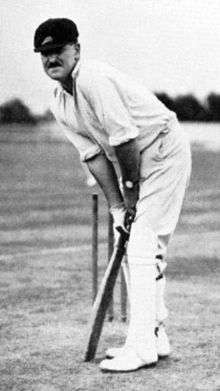Syd Hiddleston
 | |||||||||||||||||||||||||||
| Personal information | |||||||||||||||||||||||||||
|---|---|---|---|---|---|---|---|---|---|---|---|---|---|---|---|---|---|---|---|---|---|---|---|---|---|---|---|
| Full name | John Sydney Hiddleston | ||||||||||||||||||||||||||
| Born |
10 December 1890 Invercargill, New Zealand | ||||||||||||||||||||||||||
| Died |
30 October 1940 (aged 49) Wellington, New Zealand | ||||||||||||||||||||||||||
| Batting style | Right-hand batsman | ||||||||||||||||||||||||||
| Bowling style | Right-arm medium-pace bowler | ||||||||||||||||||||||||||
| Career statistics | |||||||||||||||||||||||||||
| |||||||||||||||||||||||||||
|
Source: Cricket Archive, 11 May 2014 | |||||||||||||||||||||||||||
John Sydney Hiddleston (born at Invercargill, New Zealand on 10 December 1890; died at Wellington on 30 October 1940) was a cricketer who played for Otago, Wellington and New Zealand, from 1909-10 to 1928-29, in the years before New Zealand played Test matches.
Cricket career
An all-rounder who could bat at any position in the order and bowled medium pace, Hiddleston played three matches for Otago in 1909-10 before moving to Wellington, for whom he played his first first-class game in 1913-14. In his second game for Wellington he opened the batting in the first innings with Clarrie Grimmett; Hiddleston made 64 of their opening partnership of 78.[1]
He played for New Zealand in the two international matches against Australia in 1921, one match against the MCC in 1922-23, two matches against the touring New South Wales team in 1923-24, and another two against Victoria in 1924-25. However, his performances in these matches were moderate: 270 runs at 19.28[2] and only one wicket.[3]
His best performances came in the Plunket Shield. In the three-match competition in 1923-24 he scored 163, 46, 94, 34, 18 and 150, becoming the first player to hit 500 runs in a season. He broke the record again in 1925-26, scoring 212 (against Canterbury; his highest score), 73, 14, 34 and 204; his 537 runs in a season remained the record for more than 20 years.[4] Wellington won the Shield in both of his record-breaking seasons.
The speed at which he scored his 212 is not recorded. However, he opened the batting on the first day, was 103 not out at lunch, and was fourth out not long after tea with the score at 343, on a day in which Wellington scored 494 for 9 wickets off 94 overs. So he is likely to have scored at around a run a ball.[5][6] His 204 a few weeks later was probably a little slower, but no less impressive: he came to the wicket at 18 for 1, reached his double-century in 262 minutes, and was last out in a team total of 374 off 85.1 overs.[7][8]
His best bowling performances came in two consecutive matches, both against Canterbury in 1918-19, when he took 8 for 59 (on Christmas Day) and 2 for 82[9] then 5 for 75 and 2 for 78 when the two sides met again the next month[10] for bowling figures in the two matches of 95.1-10-294-17.
He won the Redpath Cup for batsman of the season in 1921-22 and 1923-24.[11] Dick Brittenden said, "He was a thoughtful batsman, conscious of the problems of his trade; it was simply that he seemed able to resolve them more swiftly and efficiently than anyone else."[12]
Personal life
He worked as an indent agent in soft goods. His business commitments sometimes curtailed his cricket, preventing his participation in New Zealand's tours to Australia in 1925-26 and England in 1927.
He and his wife Rosina had one daughter. He died after a hernia operation.[13]
See also
References
- ↑ Otago v Wellington, 1913-14
- ↑ JS Hiddleston batting for teams
- ↑ JS Hiddleston bowling for teams
- ↑ R.T. Brittenden, New Zealand Cricketers, A.H. & A.W. Reed, Wellington, 1961, p. 86.
- ↑ Wellington v Canterbury 1925-26
- ↑ Evening Post, 2 January 1926, p. 3.
- ↑ Wellington v Auckland 1925-26
- ↑ Evening Post, 23 February 1926, p. 2.
- ↑ Canterbury v Wellington, 1918-19
- ↑ Wellington v Canterbury, 1918-19
- ↑ Redpath Cup
- ↑ Brittenden, New Zealand Cricketers, p. 85.
- ↑ New Zealand Herald, 31 October 1940, p. 11.